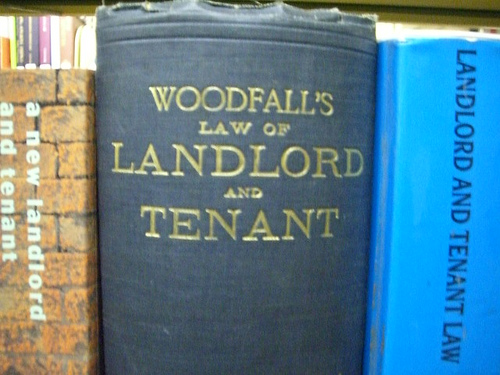Posted by Teresa on September 21, 2009 under Screening and Background Checks, Tenant Credit Checks, Tenant Screening & Background Checks | 
 It’s rather difficult to find anyone who has not been affected by the economic troubles of the past year. That includes people who want to be your tenants. What should you look for when running tenant credit checks these days? If everybody’s credit is bad, why bother to do a credit check? Should landlords and property managers lower their standards in light of the rise in rental vacancies? Read on for answers to these questions.
It’s rather difficult to find anyone who has not been affected by the economic troubles of the past year. That includes people who want to be your tenants. What should you look for when running tenant credit checks these days? If everybody’s credit is bad, why bother to do a credit check? Should landlords and property managers lower their standards in light of the rise in rental vacancies? Read on for answers to these questions.
Why bother with a tenant credit check when it’s going to be bad? Besides, if I skip it, I save money, right? Actually, the money you invest by doing thorough tenant screening will more than pay for itself when you consider the long term cost of evicting and/or cleaning up after bad tenants. And believe it or not, lots of folks are making it through the down economy by spending less, saving more, and keeping their credit records clean.
Should I lower my standards? This is a tough rental market, with rents down and vacancies up. You must decide whether to keep your qualifying standards high—and face empty units—or take a chance by lowering them in order to fill your properties. Experienced landlords say that empty units are far better than renting to bad tenants. It all depends on your tolerance risk, your cash flow—and a lot of luck.
Can I ask why a prospective tenant has had a bankruptcy? Yes. There is no time like the beginning to start communicating clearly with your tenants. If there is a bankruptcy on the credit check, ask what happened. You may find out that medical bills forced the tenant into bankruptcy, or that an ex spouse was actually the cause. Of course, if the tenant has other red flags on the credit report, you must take them into consideration, too.
Take a wide-angle view of the tenant’s credit history. If a bankruptcy is several years in the past, and everything else checks out, they may be an acceptable risk. If the bankruptcy was due to a business failure, the economy could be to blame—not the tenant. Past evictions and utility judgments are a higher risk indicators to many landlords than bankruptcies.
Do not ignore your gut instinct. If someone seems untrustworthy, they very well might be. Only you can decide whether a poor credit score or bankruptcy is worth the risk. The important thing is to perform consistent tenant credit checks!
Posted by Teresa on September 18, 2009 under Landlord Paperwork and Forms, Landlord Tips | 
 The relationship between landlord and tenant should be strictly a business one. Landlords must abide by a variety of federal, state, and local laws designed to protect tenants. Breaking a law, even unintentionally, can spell big trouble to a landlord. And rental property is too valuable to allow tenants to occupy it without the full protection of a legally binding agreement. It’s a mistake to let property without a proper rental agreement or lease. To do so opens a landlord to a great deal of risk, possible financial loss, and even litigation.
The relationship between landlord and tenant should be strictly a business one. Landlords must abide by a variety of federal, state, and local laws designed to protect tenants. Breaking a law, even unintentionally, can spell big trouble to a landlord. And rental property is too valuable to allow tenants to occupy it without the full protection of a legally binding agreement. It’s a mistake to let property without a proper rental agreement or lease. To do so opens a landlord to a great deal of risk, possible financial loss, and even litigation.
Lease or Rental Agreement?
A rental agreement allows a tenant to occupy property for a short period, often 30 days. And, it allows the landlord to increase the rent, change the terms, or terminate it altogether with a short written notice (usually 30 days, but that depends on each state’s laws). This type of agreement renews automatically at the end of the 30 days, unless the tenant or landlord gives written notice that it will end. This is a typical month-to-month type of rental situation.
A lease obligates both parties to a set of conditions and terms for a set period of time, usually one year. During the term of the lease, the landlord cannot raise the rent, and the tenant cannot move out, unless each party operates within terms of the lease that cover these areas. Landlords cannot ask tenants to move out until the lease expires. Either party can decide to not renew the lease with proper notification. Breach of the lease terms can result in eviction of the tenant by the landlord, or litigation between the parties.
Typically, the lease covers areas such as rent amount, term, rent due date, parking regulations, property care and maintenance, landlord entrance, pet policy, and other legal matters.
Rental agreements are more common in areas with high turnover, or where rents are increasing and rentals are in short supply. Leases are preferred by landlords where vacancy rates are higher or where tenants are harder to find.
Whether you decide to use a rental agreement or lease, the important thing is to make certain you are fully protected under a solid and binding legal document.
Remember, you are within your rights when
screening tenants prior to leasing. For more landlord resources, including forms and information on
tenant screening, turn to
E-Renter.com. You’ll know that you have the best possible tenants when you
prescreen tenants.
Posted by Teresa on September 14, 2009 under Screening and Background Checks, Tenant Credit Checks, Tenant Screening & Background Checks | 
 Pre-qualifying tenants means a good start to a mutually respectful, mutually beneficial landlord/tenant relationship. So what exactly is pre-qualifying, and how do you begin to implement this strategy? Here’s a list of what pre-qualifying is and is not:
Pre-qualifying tenants means a good start to a mutually respectful, mutually beneficial landlord/tenant relationship. So what exactly is pre-qualifying, and how do you begin to implement this strategy? Here’s a list of what pre-qualifying is and is not:
- Pre-Qualifying is about finding the people who fit the minimum requirements you set for income, references, job and credit history. Proper tenant screening will further narrow the field by giving you solid background check results to base your decision on.
- Pre-Qualifying is not about discrimination. As a landlord, federal law prevents you from using a person’s race, color, religion, nationality, familial status, age, gender, or disabled status to determine housing eligibility. Your state may have additional guidelines.
- Pre-Qualifying is about laying the groundwork for a great landlord/tenant relationship by communicating clearly and effectively from the start.
- Pre-Qualifying is about reducing tenant turnover by avoiding broken lease agreements and evictions.
- Pre-Qualifying is not about judging applicants based on personal appearance, the car they own, or the number of people in their family unit.
- Pre-Qualifying is about applying the same rules and requirements to all applicants.
- Pre-Qualifying is a way to reduce your risk by keeping tenants with previous criminal convictions or negative rental histories out of your rental properties.
- Pre-Qualifying is started by advertising your property for rent in the right publications, including enough information to weed out individuals who are not a good fit for your rental.
Every landlord should consider pre-qualifying tenants. While it takes effort to begin any new procedure, it will soon be a habit—and this is a habit that will pay off through better relationships with your tenants and increased profits for you!
Posted by Teresa on September 11, 2009 under Landlord and Tenant FAQs, Landlord Tips | 
 What are the guidelines when it comes to a landlord’s ability to enter a tenant’s apartment or house? It depends on your state’s laws, but in most, the landlord must provide notice prior to entering a tenant’s home.
What are the guidelines when it comes to a landlord’s ability to enter a tenant’s apartment or house? It depends on your state’s laws, but in most, the landlord must provide notice prior to entering a tenant’s home.
Do check your state’s landlord/tenant laws: they can range from “no notice required” in Massachusetts, New Jersey, and several other states; to 12 hours in Florida; to 48 hours in Vermont.
Don’t worry about advance notice in cases of emergency, such as natural gas odor, smoke or fire, or a water leak.
Don’t “knock and unlock.” Allow your tenants to answer the door, even if they are expecting you.
Don’t assume they’re not at home and let yourself in.
Do offer more than the required notice if you can.
Do specify a window of time they can expect you. And try to stick to it. Call them if you’re delayed or early.
Do leave your tenant’s home in the same condition you found it. If your shoes are muddy, remove them before entering. And clean up after yourself.
Do conduct inspections and maintenance on your rental properties with the goal of maintaining your tenants’ privacy, too!
Posted by Teresa on September 8, 2009 under Landlord Tips | 
 A landlord we know wouldn’t dream of performing his own property maintenance. Show Dave a leaking faucet, and he’s soon pulling out his Blackberry to call a trusted plumber. But this year, Dave is seeing a trend he hasn’t dealt with before—his profits have been squeezed by more tenant turnover and reduced rents.
A landlord we know wouldn’t dream of performing his own property maintenance. Show Dave a leaking faucet, and he’s soon pulling out his Blackberry to call a trusted plumber. But this year, Dave is seeing a trend he hasn’t dealt with before—his profits have been squeezed by more tenant turnover and reduced rents.
So Dave has decided to learn how to take care of minor repairs and routine maintenance on his rental properties—and he’s probably not alone! More and more landlords are becoming their own handymen and women. If you’re one of them, here are a few tips and tricks that might come in handy.
- Use separate tool totes for each area of maintenance. Purchase inexpensive handle totes: blue for plumbing, red for painting, green for general repairs, and so on. Load each tote with the appropriate tools and supplies—and don’t forget to include How-To manuals or books!
- Each tote should contain an assortment of screwdrivers, screws, bolts, and nuts, as well as gloves appropriate to the task.
- The general repair tote will serve you well if you stock it with duct tape, wood glue, super glue and drill bits. A level and socket tester will both come in handy, as will a razor blade/knife tool and socket wrench set. A hammer and a rubber mallet are musts.
- For your plumbing tote, make sure you have channel lock pliers, plumbers’ tape, and an assortment of wrenches.
- Load your painting tote with painters tape, spackle and a spackle knife, plus touch-up applicators filled with the standard paint colors you use in your properties. These look like shoe polish applicators, and can be found in hardware stores.
- Cordless tools will be your best friends! Make sure you charge them after each job, so they’re ready to use again.
With economic challenges continuing, you might need to learn how to perform repairs and maintenance on your income property—but remember to call in the professionals for potentially dangerous and complicated jobs, like electrical work and major carpentry or plumbing repairs!
Remember, you are within your rights when
screening tenants prior to leasing. For more landlord resources, including forms and information on
tenant screening, turn to
E-Renter.com. You’ll know that you have the best possible tenants when you
prescreen tenants.
Posted by Teresa on September 2, 2009 under Landlord Tips, Tenant Screening & Background Checks | 
 Do you have a guest clause in your lease agreement? If so, your tenant has agreed that no guests can stay in the rental unit longer than the time specified on the lease. For some landlords, that’s seven days; for others, fourteen. And some specify no guests for more than fifteen days out of any thirty-day period.
Do you have a guest clause in your lease agreement? If so, your tenant has agreed that no guests can stay in the rental unit longer than the time specified on the lease. For some landlords, that’s seven days; for others, fourteen. And some specify no guests for more than fifteen days out of any thirty-day period.
If your current lease agreement does not contain this important clause, make sure you add it before you sign another lease with this or any other tenant. This way, you will avoid a sticky situation: when your tenant allows a guest to stay indefinitely in your rental property.
On one hand, your tenants are free to certain enjoyment of their rental unit, including entertaining friends and hosting guests. But on the other hand, when a guest becomes a permanent fixture, you could be held liable for their actions. Having an unknown entity living in your rental unit puts you at risk, along with your other tenants, and the neighbors.
Hands-on landlords must balance staying on top of their tenant’s activities with being a nosy pest. However, you have every right to know what’s going on in and around your property. So, when you observe a guest at your rental unit who appears to have moved in, it’s time to ask the question.
If you’ve established good communication with your tenant, then asking if “Joe-Bob,” “Alison,” or “Spike” have moved in is completely reasonable. If the tenant is a good one whom you’d like to retain, then take a rational approach. Be prepared to offer options to your tenant: if they have broken the rules outlined in the lease, then they need to have the person leave, or add them to the lease—with proper background screening, of course.
It’s vital that you enforce the terms of your lease completely and evenly—every rule applies to every tenant. And, it’s important that your tenants know you mean business and that you expect them to live up to their agreement. Letting something like this slide can only lead to further—and possibly larger—problems.
Of course, hands-off landlords don’t often know who’s coming and going in their units—so their tenants can get away with stretching the terms of their lease. After all, if you’re not paying attention, they’re probably not going to tell you!
Posted by Teresa on August 27, 2009 under General | 
 The most common cause for evicting a tenant is probably nonpayment of rent. Experienced landlords do not hesitate to begin eviction procedures when tenants are in arrears on rent. So if you plan toever evict a tenant, then think like a Boy Scout—and be prepared.
The most common cause for evicting a tenant is probably nonpayment of rent. Experienced landlords do not hesitate to begin eviction procedures when tenants are in arrears on rent. So if you plan toever evict a tenant, then think like a Boy Scout—and be prepared.
Be prepared for excuses: You might hear about your tenant’s difficulties, whether from the economy, job loss, health, or even the weather. You could hear that there is damage or mold in the unit that renders it uninhabitable. You might hear any number of reasons why your tenant has not paid the rent—which is the only thing that matters. As landlord, you are entitled to decide whether or not to evict based on the tenant’s situation. Just be prepared for nonpayment of rent to occur again.
Be prepared with all the eviction paperwork required by your local court. Some want a copy of your deed, the lease, the exact names of everyone living in the rental unit (whether or not they are on the lease) and copies of all notices to pay rent or quit (evict). Your jurisdiction may want more information, so be sure to ask the clerk of court or magistrate’s office. You’ll also need proof of non-payment, so gather up all check copies for the tenant for at least the previous year.
Be prepared to hire a lawyer. If you have never evicted a tenant before, many experienced landlords would strongly recommend you hire a Landlord/Tenant attorney before proceeding with eviction. They can keep you from making crucial mistakes and losing your case.
Be prepared to spend money. There will be fees associated with preparing your case. And if you decide to hire an attorney, you will be responsible for his or her fee, as well.
Be prepared to follow the court’s procedures. The court will require you to fill out paperwork correctly and follow every procedure to the letter. If you don’t, you could have your eviction case thrown out and have to start again. Consider observing a day in court when they hear eviction cases—seeing other landlord’s eviction errors could help you avoid them.
Be prepared for a fight. Your tenant may not even show up for court. If so, you will likely win your case. But if they do appear, remember that tenants have rights, too, and are entitled to plead their case before the judge. Be prepared to defend yourself. You may hear things that will surprise you, but stick to the facts and avoid arguing or confrontation.
Eviction is never easy, but it is a part of being a landlord. Just remember to be well prepared for whatever surprises may come up!
Posted by Teresa on August 25, 2009 under Landlord Tips, Rents and Deposits, Tenant Credit Checks | 
 As the housing marketing continues to struggle, many landlords are finding themselves in a tough spot. Perhaps you’re one of them: vacancies are rising, your bank is tightening up your credit line and won’t refinance your mortgage, and you really need a positive cash flow.
As the housing marketing continues to struggle, many landlords are finding themselves in a tough spot. Perhaps you’re one of them: vacancies are rising, your bank is tightening up your credit line and won’t refinance your mortgage, and you really need a positive cash flow.
If your tenants are smart, they know that in some areas, it’s a renter’s market—and they could be planning to ask you for a rent reduction, especially if they feel they’re paying more than the market dictates.
What should a landlord do if a tenant asks for lower rent?
- Determine whether or not your tenant has a valid case for a reduction in rent. Look at your local rent market, and compare your rents to similar units. You should always be aware of the fair market value in your area—and there are plenty of resources to guide you.
- Analyze your cash flow. If you determine your rent is above market value, but you can’t lower the rent and stay profitable, look for ways to reduce expenses. Perhaps you can take over landscaping duties from your contracted service. Or, perform small repair and maintenance yourself for awhile. You could even offer a compromise, such as keeping the rent the same, but covering some utility costs.
- Analyze the tenant’s history. Does the tenant pay on time every month? Have there been any complaints against them? How careful are they with your property? If they have been a great tenant, compare the rent reduction request with the hassle of finding a new tenant. You may find that peace of mind will make the reduction more palatable.
- Advise that you will be conducting a tenant credit check—and then follow through. If your tenant’s credit status has changed since the lease was signed, a thorough screening is the only way to find out. You may discover credit problems that indicate the tenant is not a good candidate for lower rent negotiations.
As a landlord, you are in a constant balance act to obtain and keep good tenants who pay on time. As the economy starts to slowly recover, you may have to concede to belt-tightening or reducing rents in order to attract and keep your best tenants.
Posted by Teresa on August 21, 2009 under Fair Housing Act, Landlord Tips, Tenant Screening & Background Checks | 
 The Fair Housing Act, also known as Title VIII of the Civil Rights Act of 1968, prohibits landlords from discriminating against applicants on the basis of race, color, national origin, religion, sex, family status and disability. Various Executive Orders cover more details, such as requiring federal agencies to promote and further fair housing in the programs and prohibiting discrimination in the sale or leasing of properties owned by the federal government or provided with federal funds.
The Fair Housing Act, also known as Title VIII of the Civil Rights Act of 1968, prohibits landlords from discriminating against applicants on the basis of race, color, national origin, religion, sex, family status and disability. Various Executive Orders cover more details, such as requiring federal agencies to promote and further fair housing in the programs and prohibiting discrimination in the sale or leasing of properties owned by the federal government or provided with federal funds.
The FHA covers most housing in this country, but there are certain exemptions in some circumstances. If you need to know if your circumstances qualify for an exemption, check with your attorney.
Specifically prohibited actions based on the definition of the FHA in leasing situations include:
- Refusing to rent housing
- Making housing unavailable
- Setting different terms, conditions, or privileges for rental of a dwelling
- Providing different housing services or facilities
- Falsely denying that housing is available for inspection or rental
It is also illegal to threaten, coerce, intimidate or interfere with anyone exercising or assisting others to exercise their rights under the FHA, and to advertise or make a statement that indicates any limitation to housing or preferential treatment in offering housing based on race, color, national origin, religion, sex, family status, or disability.
In addition, the Fair Housing Act prohibits landlords from discriminating against tenants with physical and mental disabilities, and requires them to allow reasonable modifications to the dwelling unit to accommodate their disability. This can be done at the tenant’s expense, and, where reasonable, you may require that they return the unit back to its original condition when they move out. For example, allowing a disabled tenant special parking when requested is required.
Landlords are also required to make reasonable accommodations for disabled tenants who require service animals. Even if you have a “no pets” policy, you must allow service animals, which are not considered pets.
However, the FHA does not require that landlords make housing available to persons who are direct threats to the health and safety of others or who use illegal drugs.
Remember, you are within your rights when
screening tenants prior to leasing. For more landlord resources, including forms and information on
tenant screening, turn to
E-Renter.com. You’ll know that you have the best possible tenants when you
prescreen tenants.
Posted by Teresa on August 18, 2009 under Landlord Paperwork and Forms, Landlord Tips | 
 It’s vital to have a move-in checklist for each of your rental properties. It’s even more important to personally conduct a pre-move-in walk through with each new tenant. Do this before the tenant moves in!
It’s vital to have a move-in checklist for each of your rental properties. It’s even more important to personally conduct a pre-move-in walk through with each new tenant. Do this before the tenant moves in!
Your move-in checklist documents the condition of each room, along with its contents. When the tenant moves out, you’ll want to conduct another walk through to compare the condition and contents of each room with the move-in checklist. Then, you can determine any damages that the security deposit will cover.
Here’s what you should include on the move-in checklist:
Kitchen
- Condition of floors, walls, ceiling
- Number, condition, and description of light fixtures
- Number, condition, and description of plumbing fixtures
- Number, condition, description, and serial numbers of appliances
- Condition and description of sink
- Stove: number, condition, and description of racks, burners, broilers, hood
- Number and description of ice trays or condition of icemaker
- Condition and description of cabinets, drawers, knobs
- Condition and description of countertops
- Condition and description of doors, doorknobs, hinges, windows, windowsills, locks
Living Room, Dining Room, Bedrooms
- Condition and description of floors, walls, ceiling
- Number, condition, and description of light fixtures
- Condition and description of doors, closet doors, closet interiors, doorknobs, hinges, windows, windowsills, locks
- Condition and Description of thermostat
Bathrooms
- Condition of floors, walls, tub surround, ceiling
- Number, condition, and description of light fixtures
- Number, condition, and description of built-in fixtures: towel racks, soap holders, etc.
- Number, condition, and description of plumbing fixtures: faucet, toilet, sink
- Condition and description of tub and/or shower and caulking
- Condition and description of cabinets, drawers, knobs
- Condition and description of countertops
- Condition and description of closets, doors, doorknobs, hinges, windows, windowsills, locks
On each item, note any scratches, dents, stains, or malfunctioning components. Take photos of every room and everything in it. Note how many keys the tenant received.
And most important: both the landlord and the tenant need to initial each item and sign and date the bottom of the form. This is for the tenant’s protection, as well we yours. When move-out day comes, you’ll both have thorough documentation of each room and everything in it—which will facilitate the return of the security deposit.
 It’s rather difficult to find anyone who has not been affected by the economic troubles of the past year. That includes people who want to be your tenants. What should you look for when running tenant credit checks these days? If everybody’s credit is bad, why bother to do a credit check? Should landlords and property managers lower their standards in light of the rise in rental vacancies? Read on for answers to these questions.
It’s rather difficult to find anyone who has not been affected by the economic troubles of the past year. That includes people who want to be your tenants. What should you look for when running tenant credit checks these days? If everybody’s credit is bad, why bother to do a credit check? Should landlords and property managers lower their standards in light of the rise in rental vacancies? Read on for answers to these questions.








